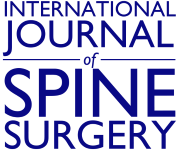Article Figures & Data
Tables
- Table 1
Demographics of patients in clinical series undergoing minimally invasive transforaminal lumbar interbody fusion
Reference Number of patients in study Mean age in years (range) Male/Female Mean number of follow-up months Study type Peng et al, 200918 29 54 (26-74) 5/24 24 Prospective Schizas et al, 200926 18 45.5 (NA) NA 22 Retrospective Dhall et al, 200825 21 53 (NA) NA 24 Retrospective Park et al, 200819 40 56 (38-71) 19/21 35 Retrospective Scheufler et al, 200720 53 57 (NA) 24/29 16 Retrospective Beringer et al, 200624 8 49 (35-63) NA 9 Retrospective Deutsch et al, 200621 20 49 (33-55) 12/8 6 Retrospective Jang et al, 200522 23 60 (48-68) 8/15 19 Retrospective Schwender et al, 200515 49 NA (23-80) 19/30 23 Retrospective Abbreviation: NA, not available.
- Table 2
Postsurgical radiographic outcome data for patients undergoing minimally invasive transforaminal lumbar interbody fusion
Reference Number of patients in study Arthrodesis rate Graft subsidence Peng et al, 200918 29 * Grade 1: 80% 0% * Grade 2: 20% Schizas et al, 200926 18 83% 5.6% Dhall et al, 200825 21 95% 5% Park et al, 200819 40 100% 0% Scheufler et al, 200720 53 94% 0% Beringer et al, 200624 8 100% 0% Deutsch et al, 200621 20 65% 0% Jang et al, 200522 23 95% 13% Schwender et al, 200515 49 100% 0% ↵* Bridwell anterior fusion grading system: Grade 1 – evidence of fusion with remodeling and trabaculae present; Grade 2 – evidence of intact graft with incomplete remodeling or incorporation, and without lucency; Grade 3 – evidence of intact graft with lucency both above and below the graft; Grade 4 – evidence of collapsed or resorbed graft and absence of fusion.
- Table 3
Postsurgical functional outcome data for patients undergoing minimally invasive transforaminal lumbar interbody fusion.
Reference Number of patients in study Functional outcome data Peng et al, 200918 29 Leg pain VAS improved from 7 to 1 Back pain VAS improved 6.5 to 1 NASS for neurogenic symptoms improved from 3.6 to 1.2 NASS for back pain improved from 3.2 to 1.5 ODI improvement from 45.2 preoperatively to 16.2 at 2 Significant improvements in SF-36 parameters Schizas et al, 200926 18 VAS improved from 7.7 to 3.5 ODI improved from 55 to 33 Dhall et al, 200825 21 Modified Prolo score improved from 11 to 19 Park et al, 200819 40 Leg pain VAS improved from 65 to 8 Back pain VAS improved from 52 to 15 ODI improved from 55 to 16 Scheufler et al, 200720 53 VAS improved from 5 to 1.5 Roland-Morris scores improved from 18 to 4 at 8 mos, and to 3 at 16 mos AAOS neuro score improved from 33 to 15 at 8 mos, then to 12 at 16 mos AAOS physical health and pain score improved from 65 to 22 at 8 mos, then to 18 at 16 months AAOS pain disability score improved from 80 to 40 at 8 mos, then to 25 at 16 mos Beringer et al, 200624 8 Modified Prolo score improved from 11 to 18 Deutsch et al, 200621 20 VAS improved from 8.3 to 1.4 ODI improved from 57 to 18 Jang et al, 200522 23 Mean NRS score improved from 7.5 to 2.3 for back pain Mean NRS score improved from 7.4 to 0.7 for leg pain ODI improved 33.1 to 7.6 Schwender et al, 200515 49 VAS improved from 7.2 to 2.1, while the ODI improved from 46 to 14 Abbreviations: AAOS, American Academy of Orthopedic Surgeons; NASS, North American Spine Society; NRS, Numeric Rating Score; ODI, Oswestry Disability Index; VAS, Visual Analog Scale.






